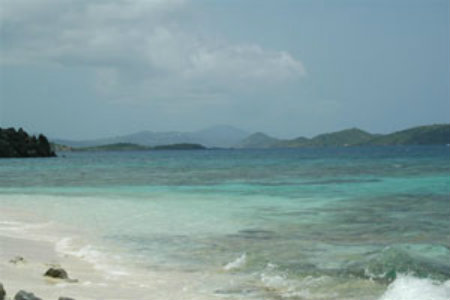
Courtesy of the National Park Service (John Mattox)
Virgin Islands National Park covers roughly 60% of St. John Island in the United States Virgin Islands. Often thought of primarily as a place of natural beauty, the park also preserves the history and tells the stories of the rich cultural mix of peoples in the Caribbean--Native Americans from South America, enslaved Africans, European colonists, and, after 1917 when the Virgin Islands became part of the United States, Americans. Today, visitors to St. John can marvel at the beauty of the island, enjoy a variety of outdoor recreational activities, and learn more about the Native Americans and European colonization in the Caribbean.
The first people in the Virgin Islands arrived from South America by canoe beginning about 710 BCE. They settled in a number of places, including along the south shore of St. John. One group, the Taino, formed villages along the many bays of the island. Over the next several hundred years, the population of the Taino and other groups grew and spread out until the arrival of Christopher Columbus in 1492. Following Columbus, Spain tried to establish a colony. The Spanish colonists and native peoples fought, and fighting and disease killed many of the local people. Visitors to the park today will find the remains of the native Taino culture in archeological sites and petroglyphs such as the ones along the Reef Bay hiking trail on St. John.
Spain, Holland, England, and Denmark have all made claims in the Virgin Islands--Saint Croix, Saint John, Saint Thomas, Water Island, and numerous outlying minor islands. The Danish presence is most evident on St. John in Virgin Islands National Park. The first Danish colony dates from 1672. Over time, the Danes established plantations worked by slave labor. On St. John, a large workforce of slaves harvested the major plantation crops. At first, the main crops were tobacco, plants for the creation of dye, and native crops. Production later shifted to two labor-intensive, yet profitable, crops: sugar and cotton.
As long as sugar and cotton prices held, the plantations on St. John prospered. In 1792, however, Denmark abolished the slave trade and eliminated the source of free labor that had helped ensure the success of the plantation economy. Further, sugar and cotton prices declined in the early 1800s. The total abolition of slavery by Denmark in 1848 ended an already struggling cotton and sugar based economy, and large land owners who had owned slaves often divided their lots into smaller farms or abandoned them to nature.
Legacies of a plantation system remain, however. Annaberg was once one of the larger sugar plantations on St. John. The remains of the windmill and horsemill, used to crush the sugar cane to extract its juice, still stand. Much of the sugar factory, where the juice was boiled and condensed to make raw sugar, is still there, as is part of the rum still. Slaves gathered in the sugarcane stalks, closely supervised their successive reduction into syrup, and packed the sugar for export. The slaves lived in quarters on the plantation and were required to follow strict rules of conduct that required obedience to their master. Overseers helped to maintain order and enforce discipline.
Visitors to Annaberg will note one tool of the overseer and a symbol of the conditions against which enslaved Africans fought—a dungeon. Cultural demonstrations, including baking “dumb bread” and basket weaving take place Tuesday through Friday from 10 a.m. to 2 p.m. Parts of the Annaberg School, used to educate the children, are located not far from the sugar mill.
Catherineburg, another sugar plantation and factory in the park, is located on Centerline Road overlooking Cinnamon Bay. Here much of the windmill and the boiling house remain.
Visitors can hike to the Reef Bay Sugar Mill. On Mondays and Thursdays, rangers lead hikes down a 3-mile path through tropical forests to the sugar mill. Reservations are required and there are fees for taxi transportation to the trailhead and boat return to the visitor center. See the Visitor Activities brochure for more details.
Virgin Islands National Park is the site of other sugar and cotton plantations in addition to the plantations at Annaberg, Cinnamon Bay, and Reef Bay. Some are described in thePuerto Rico and the Virgin Islands Travel Itinerary.
Lush tropical Virgin Islands National Park draws tourists from all over the world to enjoy the scenery and beautiful beaches; snorkel, swim and sail in the waters; picnic; and camp. But visitors should not miss the opportunity to learn about the native peoples, European colonists, and enslaved Africans who peopled this paradise by visiting the fascinating historic sites that tell their stories.
Virgin Islands National Park, part of the National Park System, is located on St. John Island in the United States Virgin Islands. There are no official entry points into the park, though visitors may wish to begin at the visitor center at Cruz Bay near the ferry dock. The visitor center offers orientation materials on the park.The park may be visited either by automobile once on St. John, or by ferry or private boat. There is a fee to enter the park through Trunk Bay. Boats moored at Park Service mooring balls must also pay. The park is generally open all the time. The visitor center at Cruz Bay is open from 8:00am to 4:30pm daily. For more information, visit the National Park Service Virgin Islands National Park website or call 340-776-6201.
Last updated: August 11, 2017
